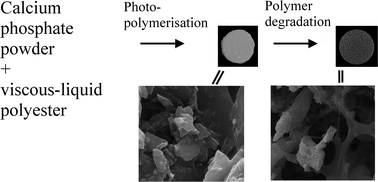In this study, the influence of a biodegradable polymer matrix on the conversion of tetracalcium phosphate (TTCP) or TTCP–monocalcium phosphate monohydrate (MCPM) powders was investigated. As a reference, the properties of three calcium phosphate cements (CPCs) based on TTCP or TTCP–MCPM mixtures were discussed. Additionally, the influence of these calcium phosphate (CP) reacting powders on the polymer degradation was studied. Composites were formulated by mixing cross-linkable dimethacrylates of the ε-caprolactone/glycolide co-polymer with hydroxyethylmethacrylate, a photo-initiator and TTCP or TTCP–MCPM. The composite samples were set by visible light irradiation. CPC and composite samples were immersed in HEPES at 37 °C. The CPC based on TTCP converted to a carbonated apatite. Adding MCPM to the TTCP powder improved the conversion of TTCP. By varying the MCPM/TTCP ratio it was possible to tailor the conversion reactions so that an apatitic phase could be formed via intermediate products like DPC, DCPD and OCP. In the composites, a mutual interaction between the CP reacting powders and the polymer was observed. The co-polymer and its degradation products influenced the conversion reactions of the CP reacting powders. The degradation products tend to enhance the TTCP conversion after a long immersion time. The conversion of the TTCP–MCPM mixtures was retarded by the polymer matrix although the intermediate products were not altered. The basicity or acidity of the CP reacting powders and their conversion reactions were the main cause for the retarded polymer degradation, which was more pronounced when the basicity of the CP reacting powders increased.

You have access to this article
 Please wait while we load your content...
Something went wrong. Try again?
Please wait while we load your content...
Something went wrong. Try again?


 Please wait while we load your content...
Please wait while we load your content...